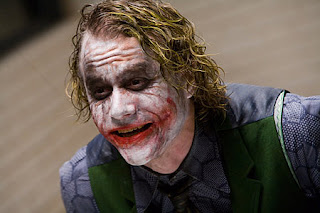
David Denby for his wrongheaded review of The Dark Knight in the New Yorker.
He starts off with a long catalog of the ultraviolence --
"In the new Batman film, The Dark Knight, many things go boom. Cars explode, jails and hospitals are blown up, bombs are put in people’s mouths and sewn into their stomachs. There’s a chase scene in which cars pile up and ..."
And on and on and on. Oh the humanity.
Which is sorta like saying, “In Hamlet there’s incest behind the curtains, a stabbing behind a curtain, lots of stabbings right out in the open, an adolescent girl who drowns herself, a bipolar nutcase talks to ghosts and a skull, a little poison and plenty of blood, blood, blood.”
All that slaughter supports the conclusion:
“In brief, Warner Bros. has continued to drain the poetry, fantasy, and comedy out of Tim Burton’s original conception for Batman (1989) …”
Tim Burton didn’t invent Batman. Bob Kane and Bill Finger did.
OK, stupid. I enjoyed Burton’s two movies. That said, they’re a dead end. Nolan’s concept is better. Here’s why:
Christopher Nolan takes the premise of Batman seriously. (The original premise, however retooled.) Tim Burton didn’t. What Burton created was ultimately arty and operatic, not a self-consistent reality.
Here, Burton runs into a basic law of comic book physics: If the Batman universe gets too disconnected from our own, it inevitably turns into the campy Batman. If you don’t take the concept seriously, inevitably, your audience starts to laugh at it. You can tell yourself “It’s a post-modern” all you want.
Burton’s two Batman movies had damn good scripts and creepy sets echoing Brazil and Blade Runner. Burton started out dark, atmospheric and operatic. But where do you go from there? The basic building block: mood. Not causality, character, plausibility and logic. Burton’s world was dark, but it wasn’t believable. You know it’s not real. It stops being scary. That makes it funny.
So, in the first movie, when the Joker zaps a crook with a joy buzzer and starts rapping with the fried corpse, it’s a hoot. He kills people with consumer products. He tries to gas Gotham with Macy’s balloons full of Zyklon B. He fights Batman on a belltower and whips on a pair of funny specs. “You wouldn’t hit a man with glassses, would you?” Wham!
By the end of Burton’s second movie, he gave us a march of the penguins with RPGs strapped to their backs. Waugh. Waugh. From there, it went to other directors and devolved to candy colored kaka and a batsuit with nipples
We're not that far away from Batman and Robin in the toaster.
--Holy hotpoint Batman. I think we're toast!
--Hold on, old chum. I think there's a way out of this.
Mercifully, the campy TV series died. Mercifully, the latest incarnation of the Batman movies died. Mercifully, Nolan is taking it in the right direction.
Stupid.





.jpg)